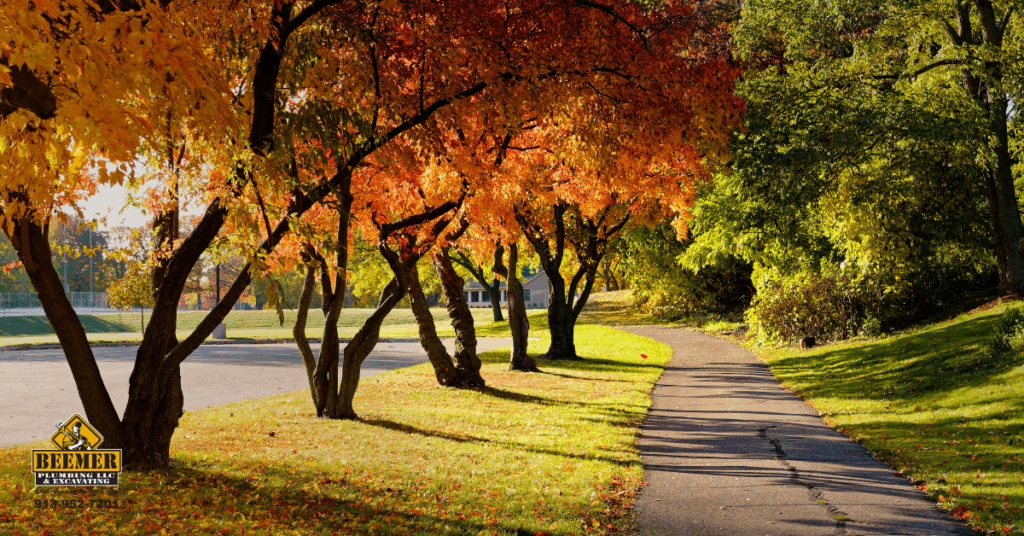As October rolls in across the Kansas City Metro and Johnson County, the days get shorter, and the nights get colder. For homeowners, that means preparing your plumbing system for freezing temperatures, heavier heating demands, and the stresses winter can place on pipes, water heaters, and sewer lines. At Beemer Plumbing, we’ve seen too many winter disasters that could’ve been avoided with just a little preparation. Below is your checklist of 7 plumbing tasks to tackle this fall—before the freeze—and how our team can help you get them done.

7 Plumbing Tasks to Tackle This Fall
1. Insulate Vulnerable Pipes & Exposed Plumbing
Cold snaps can catch you by surprise. Pipes in unheated areas—like basements, crawl spaces, garages, attics, and along exterior walls—are especially vulnerable to freezing and bursting.
- Use foam or fiberglass pipe insulation sleeves.
- Seal gaps or cracks in walls or foundations near plumbing runs so cold air doesn’t reach pipes.
- Install insulated faucet covers on exterior hose bibs and shut off and drain outdoor spigots.
Proper insulation pays off: fewer burst pipes, fewer emergency calls.
2. Drain & Flush Your Water Heater
Sediment naturally builds up in your water heater over time. That reduces efficiency, stresses components, and can shorten lifespan—especially when heating demands increase in winter.
- Turn off power or gas to the heater, attach a hose to the drain port, and flush until the water runs clear.
- Inspect the pressure relief valve to make sure it opens and reseals properly.
- Check for leaks or signs of corrosion around fittings and connections.
If your water heater is more than 10–12 years old, consider scheduling a replacement before winter stress pushes it over the edge.
3. Test & Adjust Sump Pump / Floor Drains
Even in colder months, heavy rain or melting snow can overwhelm drainage systems. A failing sump pump or clogged floor drains can lead to flooding in basements or low-lying areas.
- Pour water into the sump pit to confirm the pump activates.
- Clean the screen, inlet, and discharge line.
- Ensure the discharge path slopes away from your foundation.
- For floor drains, use a plumber’s snake or water flush to clear minor buildup before it becomes a serious blockage.
4. Camera-Inspect & Clean the Main Sewer Line
Fall is an ideal time to inspect your main sewer line before freezing and thaw cycles can shift soil and root growth. Hidden clogs, tree root intrusions, or old pipe fragility tend to worsen in colder months.
- A sewer camera inspection reveals damage, roots, or blockages before they lead to backups.
- A professional cleaning (hydro jetting or mechanical snaking) can clear buildup.
- Based on inspection, we can recommend trenchless repairs (pipe bursting, pipe lining) or conventional replacement as needed.
5. Test Your Water Pressure & Check for Hidden Leaks
Winter’s lower humidity and drier indoor air make small leaks more noticeable. Meanwhile, high water pressure places extra stress on fixtures, joints, and seals.
- Use a pressure gauge on a hose bib—optimal household pressure is usually 40–60 psi.
- If pressure is too high (over 70 psi), consider a pressure-reducing valve (PRV).
- Inspect under sinks, behind appliances, and around fixtures for moisture, corrosion, or stains that suggest slow leaks.
A hidden pinhole leak in freezing weather can quickly balloon into a full-blown disaster.
6. Service & Inspect Gas Lines, Appliances & Vents
Many homes shift to more gas-fired heating in the colder months. It’s essential to ensure safety and proper operation.
- Inspect gas lines, valves, and connections for signs of corrosion, leaks, or damage. Beemer Plumbing offers gas line repair and replacement services.
- Check your furnace, boiler, water heater, and gas fireplaces to ensure ventilation is clear and flue chimneys are unobstructed.
- If you have a gas fire pit or outdoor heater, winter is a good time to check for leaks or cracked piping before next season. Beemer handles exterior gas line services as well.
Safety first: gas line issues can be dangerous if ignored.
7. Identify & Fix Low Spots / Poor Drainage Around Your Home
When snow melts or we get strong winter storms, water can pool around your foundation, saturating soil and putting pressure on basement walls and plumbing penetrations.
- Walk around your home and look for low zones or spots where water often puddles.
- Add or regrade soil, adjust downspouts to discharge further from your foundation.
- Ensure gutter and downspout systems are clean and functioning.
- Consider installing or maintaining French drains or yard drainage systems connected properly to your sewer or storm drain.
Proactive grading and drainage reduce hydrostatic pressure, avoid seepage, and protect foundation plumbing.
Why October Is the Best Month to Do This Work
- The ground is still workable (not frozen solid), making outdoor projects easier.
- You’re ahead of the first freeze—giving time to catch issues before damage happens.
- Plumbing contractors often have more schedule flexibility before full winter demand hits.
- Preventive work is much cheaper and less stressful than emergency winter repairs.
How Beemer Plumbing Can Help You Winter-Ready
At Beemer Plumbing, we specialize in whole-house plumbing, underground utilities, gas line work, leak detection, commercial and residential systems, and trenchless solutions.
Here’s what our team can offer:
- Full plumbing winterization inspections
- Pipe insulation and sealing services
- Water heater flush and diagnostics
- Sewer camera inspections and cleaning
- Gas line checks & repair
- Drainage advice and installation support
- Emergency prep and planning
Let us help you lock in peace of mind before winter arrives. Contact Beemer Plumbing today to schedule your fall plumbing checkup: (913) 952-7701 or through our contact form.